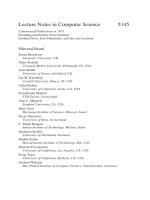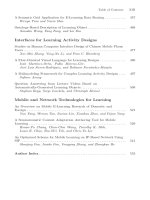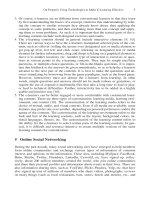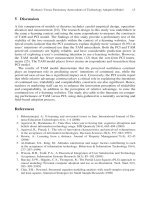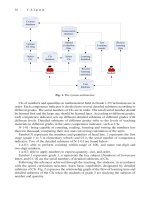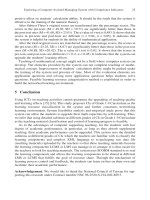Lecture Notes in Computer Science- P52 pdf
Bạn đang xem bản rút gọn của tài liệu. Xem và tải ngay bản đầy đủ của tài liệu tại đây (360.77 KB, 5 trang )
244 J H. Chen et al.
missions to the learners. Learners could utilize the PPC to get these game mission
data and continue the game mission solving progress. Learners could utilize the
GPS/GIS functionalities to ensure the right gaming route, and use the RFID reader to
start a particular game mission. When they finished all assigned missions, they are
able to unlock other hidden game missions and related game elements. The related
work flow is shown in Fig. 3.
Fig. 3. Game Course Learning Flow Fig. 4. Game server architecture
3 U-GBL System Modules
In this section, we would like to illustrate the system modules in mobile client, game
server and authoring tool, respectively.
3.1 Game Server Modules
Fig. 4 shows the sub-modules of Game server as described below.
• Connection Module is responsible for wireless connection processing and nor-
mal connection processing.
• Connection Protocol Processing Module is responsible for the pre-processing of
data connection protocol, as well as for the transferability of data format be-
tween wireless connection mode and normal connection mode.
• Gaming Static Processing Module focuses on managing the transmission data
format and transmission mode.
• Game Course Processing Module applies to integrate and manage all data for
the map processing module, learner’s learning status processing module, course
content processing module and gaming status processing module.
Developing the Historical Culture Course by Using the U-GBL Environment 245
• Map Processing Module processes the related course and geographic informa-
tion. It uses the feedback data from the GPS Data Processing Module and GIS
Map Processing Module to present the related geographic information data. GPS
Data Processing Module focuses on processing the GPS data from the mobile
client, and sends specific GPS data to Map Processing Module. GIS Map Proc-
essing Module uses the GPS and related gaming data to make request command
and send this request to GIS server.
• Learner’s Learning Status Processing Module serves the management of
learner’s learning status and assessment. It utilizes the integrated feedback data
from the Learner Assessment Module, Gaming Behavior Analysis Module and
Learning Behavior Analysis Module. Learner Assessment Module focuses on
learning assessment. Learner’s learning status data could be loaded and proc-
essed from LMS by Learner’s Learning Status Processing Module. Then,
Learner Assessment Module could get and process the learner’s learning status
data from Learner’s Learning Status Processing Module, and restore these data
in LMS. Gaming Behavior Analysis Module focuses on managing the learner’s
gaming activities. Learning Behavior Analysis Module processes the course
learning status and result. Learner’s Learning Status Process Module integrates
and processes the data form the Gaming Behavior Analysis Module and Learn-
ing Behavior Analysis Module. Finally the Learner Assessment Module serves
the assessment analysis and stores the result in LMS.
• Course Content Processing Module focuses on content package compressing
and decompressing.
3.2 Authoring Tool Modules
The Authoring Tool Modules aims at generating the Ubi-Media course content. Some
important sub-modules are shown in Fig. 5as illustrated below.
• General Connection Processing Module manages the data connection.
• Game Course Combined Module manages the course format checking and data
compressing.
• Video Course Edit Module is responsible for managing and providing the inter-
active game elements, puzzle style and game mission content.
• Video Game Course Edit Module integrates the Adaptive User Interface Presen-
tation Module and Video Course Edit Module to provide the adaptive learning
content editing interface for course designers.
• Assessment Rule Edit Module manages and provides the assessment rules.
• RFID Tag Edit Module focuses on course information processing, data checking
and accessing.
• Map Mission Edit Module processes the mission data. RFID Tag Edit Module
could produce some related RFID data and put them into the RFID tags. The
processing results provided by Map Mission Edit Module and RFID Tag Edit
Module will be integrated by Video Game Course Edit Module.
• Adaptive User Interface Presentation Module provides the adaptive authoring
interface according to the preferences of course designers.
246 J H. Chen et al.
Fig. 5. Authoring Tool modules Fig. 6. Mobile client modules
3.3 Learning Client Modules
Learning Client Module can be considered as the gaming platform for learners, and
some important modules are shown in Fig. 6, and related descriptions are discussed as
follows.
• Connection Module and Connection Protocol Processing Module is similar to
Backend Server Connection Module mentioned in the previous section.
• Game Course Processing Module presents and manages the learning and gaming
status.
• Map Processing Module is responsible for map information processing, and co-
ordinates with GPS Data Processing Module and GIS Map Processing Module.
GPS Data Processing Module analyzes the GPS position and sends the dataset to
GIS Map Processing Module to make the formal command request. And finally,
Map Processing Module will send the formal request to game server and wait for
the response from the backend server.
• Video Game Course Processing Module serves the course decompressing, proc-
essing and presenting.
4 U-GBL Game Content Design
In this section, we would like to introduce the course content for suitable game activi-
ties in our U-GBL environment. The related subjects are described in Table 1.
Developing the Historical Culture Course by Using the U-GBL Environment 247
Table 1. Game Mission Design
Course Type Local history and culture are involved.
Course Objective Understand the local history and culture in real gaming activities in
order to improve the impressions of learning content.
Learner Type Normal Learners.
Prerequisite knowledge Being familiar with manipulating mobile learning devices.
Learning portfolio record
mode
Utilize the GPS and RFID positioning technologies to manage the
learning path and related learning status.
Main game mission To identify the celestials of “happiness”, “fortune” and “health” as
shown in Fig. 7.
Sub game mission To identify the roofs according to the elements in Chinese cosmol-
ogy
In game mission designing phase, according to the course content type, learners
should utilize their live observation to learn the course content to improve the learning
efficiency in remembering, understanding and comprehending. Accordingly in game
missions designing phase, we have to consider some properties of game mission as
shown in Table 2.
Table 2. Game Mission Properties
The key of main items Mission properties descriptions
Course subject Course content: The historic monument, representative vision,
natural landscape, geographical features of a place and lan-
guage could be a candidate for being a course content.
Mission types Main Mission (Default): To arrange the main game plot.
Sub Mission: To arrange the sub game plot.
Learning activity types Collaborative learning style (Default): To cooperate with other
team in order to get the mission reward point together.
Competition learning style: To contest with other team in
order to get the mission reward point respectively.
Techniques used Technologies operation training: Such as photographing, post
processing and manipulating system by using PPC are in-
volved.
Relationship and team work abilities: Learners can talk to
related people in order to get the related hint information.
Language: To utilized particular language to talk to related
people in local location.
Cognitive Layer We utilized the two-way specification table proposed by [15].
Cognitive process dimension: Comprised of six items, includ-
ing Remembering, Understanding, Applying, Analyzing,
Evaluating and Creating.
Knowledge dimension: Comprised of four items, including
Factual knowledge, Conceptual knowledge, Procedural knowl-
edge and Meta-cognitive knowledge.
Knowledge of course
content
The course content contains cross-domain knowledge that not
only exists in one particular book but also in multiple books.
This Field will record the related particular book content and
chapter.
248 J H. Chen et al.
Table 2. (continued)
Learners Amount Due to the limitations on location and learning effect, the amount
of learners should be around 3 to 9 people. The default value is
set to 3.
Mission Time The total time for gaming activities.(10 minutes as default)
To prompt the end time
of game mission
To give a hint before the end of game mission. (5 minutes as
default)
Mission Points The points for each solved game mission. (10 Points for each
mission as default)
Mission Time Period The suitable time period for missions.
Mileage Each processing unit is measured in meters. (50 meters as de-
fault)
We will give the game mission design example as follows.
(1) Main mission design: At Danshui Zushi Temple
The celestials of “happiness”, “fortune” and “health” in many Chinese temples
stand for blessing, wealth and long life respectively. Fig. 7 shows a main mis-
sion to photographic the celestials of “happiness”, “fortune” and “health” in or-
der and to send these photos back to the game server.
a. Mission workflow:
• Learning prerequisite knowledge: The prerequisite knowledge might
be getting familiar with the manipulating of camera, GPS and related
device. It also contains the background knowledge for the mission and
related software functionalities.
• Objectives:
¾ Search for the celestials of happiness, fortune and health.
¾ Take the photo in particular order.
¾ Send back information, such as GPS data, gaming time, photo
data and interactive portfolio to the gaming server.
(2) Sub-mission design: Along the way to the Danshui Zushi Temple
Fig. 8 shows a sub mission that when learners try to solve the abovementioned
main mission, they could see some special building material along the way. This
sub mission aims at finding them, taking three photos and sending them back to
the game server.
a. Mission workflow:
• Learning prerequisite knowledge: The manipulating of camera device,
mission map and related system functionalities via PPC.
• Objectives:
¾ Search for the building on screen.
¾ Take a shot on the building framework.
¾ Talk to local residents and get some related information about
the building framework.
¾ Send back information, such as GPS data, gaming time, photo
data and interactive portfolio to the gaming server.
